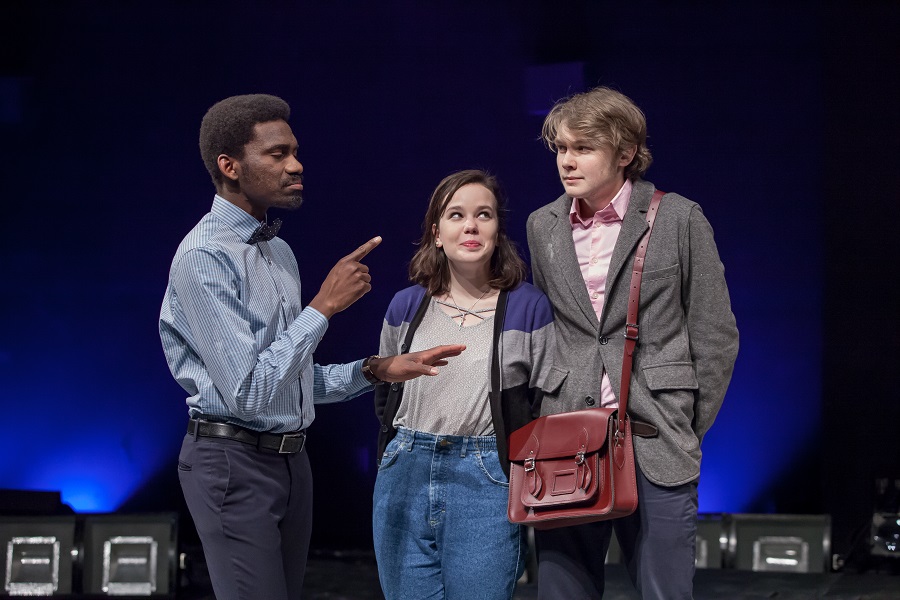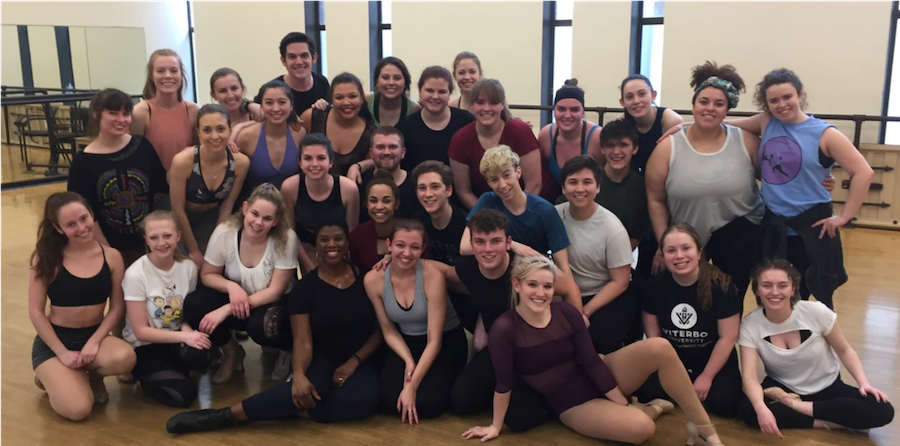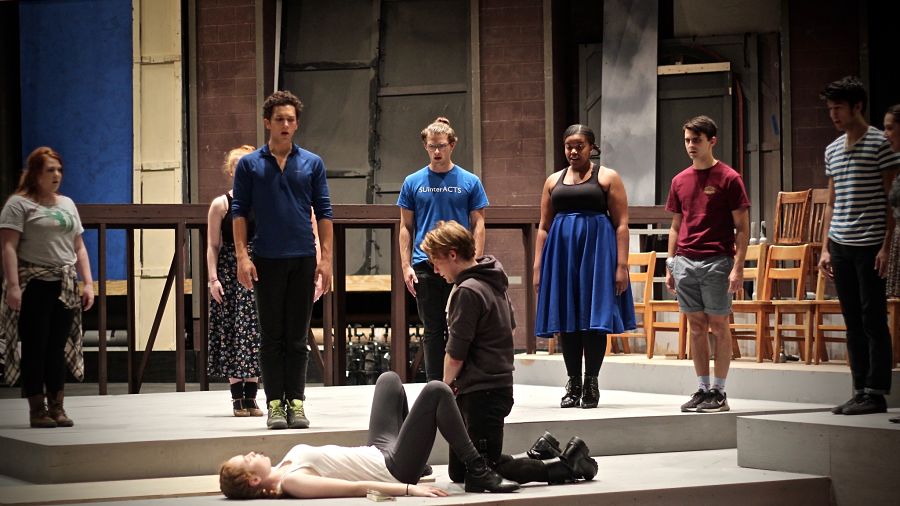When incoming theatre students step onto Xavier University’s campus in Cincinnati for freshman year, their warm welcome includes an inaugural audition for a mainstage production. There’s a sort of alchemy that forms when bringing together the “best of the best” high school theatre kids to comprise a freshman class—and an inevitable competitiveness among the students. But Stephen Skiles (he/him), the director of the theatre department at Xavier, aims to nip that cutthroat impulse in the bud. “Students come in thinking auditions are a competition against all these other people, and we try to work very early on and say it’s a competition between you and your own preparation,” says Skiles.
Holding auditions for productions in school theatre programs—particularly those with thousands of hopeful students and just a few admission slots—may seem excessive. But understanding the casting process and its role in the professional theatre industry is integral to building a life as an actor. Professional auditions are sometimes mere minutes long, and actors are tasked with packing that short window with 16 bars that show off their range, monologues, cold readings, and a winning impression of their personality. Many programs train students with mock auditions, business of acting courses, showcases, and, of course, performance opportunities won through auditions. For Skiles, learning about how to navigate auditions is a throughline of the four-year B.A. program at Xavier University. “We’re training these students to get out and to get cast in shows, so we want them to have that experience.”
Not all theatre programs favor this hit-the-ground running approach to student auditions. At Viterbo University in Lacrosse, Wisc., freshman students are not permitted to audition for fall productions. “It allows them to kind of settle in during the first semester,” says Erin Jerozal (she/her), chair of theatre and music theatre. Instead, the freshman students are offered opportunities behind the scenes to get acclimated to the program. “They are working on practical projects, and that’s often how they’ll get to know upperclassmen and get to know how the building functions.”
At the University of North Carolina School of the Arts in Winston Salem, N.C., freshman and sophomore students are relegated to the classroom and do not appear onstage at all. The first two years of the BFA program focus on the craft of acting and breaking habits, and this time allows the program directors to get to know the students’ strengths and an idea of what roles would showcase (and stretch) their talents. “The short answer is, we don’t do auditions,” says Scott Zigler (he/him), the dean of the school of drama. Graduating students, however, have 40 mock auditions under their belt—and four mainstage performances.
“You know the famous theatre story about the guy who said there are no small roles, only small actors? He was wrong,” says Zigler. “There are bigger and smaller ones. We can’t put everyone into a lead role in every play, but we want to make sure that everyone has had an opportunity to play one of the more principal roles.”
Casting and performance opportunities often go hand in hand. While schools don’t generally guarantee meaty mainstage roles for students—or any roles at all—many programs do their best to provide onstage experience for students. “We are here to help them grow as artists,” says Jerozal of Viterbo University. “We want them to have practical hands-on application of what they’re learning in the classroom.”
James Kenna (he/him), a 2019 graduate of Fordham University’s theatre program in New York City, held a record of being cast in the most shows as an undergraduate. He appeared in 14 productions, but he graduated with two fellow students who’d never been cast throughout the four-year program. “This is the anomaly, considering each semester had around 12 fully produced casting opportunities, sometimes more,” Kenna shared in an email, acknowledging that he had a leg up. “I’m an athletic cis white guy who’s pretty well represented in the theatrical canon. I’m not sure if guaranteed casting fixes this, but the selection of shows certainly helped me rack up that number.”
I myself was among my school’s students-in-waiting. While I performed in a number of student-led shows, I never got to perform in a mainstage show at Pace University. The closest I got was understudying every female role in a mainstage production of Neil LaBute’s Some Girls, but even after my castmate broke a pinky onstage, I never got the chance to recite any of the many lines I’d memorized. Jerozal aims to relieve her students of feeling like the program doesn’t believe in them: “We shouldn’t be accepting students we don’t feel we want to support in their time with us.”
Given this and other concerns, programming a season of mainstage plays and musicals to be produced as part of a theatre program is no easy feat. For programs dedicated to offering performance majors the opportunity to step onstage, season planning becomes a numbers game. At Xavier University, Skiles is tasked with the tall order of finding opportunities for the 90 theatre students on campus—a process that naturally favors shows with large casts.
The other challenge of curating performance opportunities is to select shows that will serve as learning opportunities. “If we look at our student body and think, ‘Oh, we can cast this easily,’ then we don’t do that show,” says Skiles. “We’re supposed to be offering the opportunity in a safer environment to challenge students, and to help them become comfortable with the uncomfortable.”
Shenandoah University in Winchester, Va., programs a variety of shows—from Golden Age tuners to contemporary rock musicals—to provide students a sampling of different styles over their four years. Three musicals and three plays are mounted each year, and student groups round out the programming with student-led Shakespeare productions and weekly readings of new plays.
A season planning committee considers what shows would be valuable to add to the school’s repertoire. “We decided to add students to that group to be representatives and to have a voice for the musical theatre department, the acting department, and the technical department,” says Kevin Covert (he/him), the director of Shenandoah’s musical theatre program. “What are they excited about doing?” Viterbo University students are also invited to help steer the decision-making process of what shows get produced. “There’s more students on that committee than there are faculty, and so they have a very strong voice in the season that we choose,” says Jerozal.
But who gets to play which roles? There can be a delicate dance between learning opportunities in the safety of the classroom, where students of varying backgrounds and types may study all kinds of dramatic writing—white students may study August Wilson monologues, for instance), and casting appropriately for public productions (see Yasmin Zacaria Mikhaiel’s essay for more on this subject).
“It’s about trying to find a balance where we are pushing the industry to rethink some of the typical ways things are cast both with gender and with race, but also having very honest conversations,” says Jerozal. “Is this going to be a role that we explore with you in class, or is this going to be a role that we are able to support exploring as part of our season?”
These questions have been top of mind for theatre program administrators following the release of the We See You White American Theatre demands this past summer. The document states, “We demand the choosing of culturally specific material that reflects the full spectrum of what will be asked of BIPOC students as working artists. This includes the curation of diverse performance expressions for BIPOC students that reach beyond the scope of the reinforcement of racist tropes.”
The Broadway Advocacy Coalition held a virtual convening this summer on how educators can best support BIPOC students both in the classroom and with casting opportunities and choices. Educational institutions are charged with providing opportunities for students while also carefully preparing them for an industry (and world) rife with white supremacy and misogyny. It can be especially tricky for educators to strike a balance between providing realistic advice about the industry’s expectations and simply reinscribing those prejudices. In a 2018 speech at the Humana Festival, playwright A. Rey Pamatmat spoke about undergraduate acting professors who saw his ethnicity and queerness as limiting and urged, “To all those educators and future educators listening right now, I implore you to consider whether it’s best to subject your students to bigoted systems, possibly for the first time in their lives, or to teach them about bigoted systems and how to handle them,” Pamatmat said. “The former shows them (and their peers witnessing their treatment) how to perpetuate bigotry when they’re leaders in the field themselves, while the latter gives them and their peers strategies for navigating and maybe even eliminating these challenges.”
Viterbo University is a predominantly white institution in a predominantly white region of the country, a reality that affects the program’s season selection process. “We aren’t choosing anything in our season where there’s only one person in our building who could play that role,” says Jerozal. Last year, the program tabled Larissa FastHorse’s The Thanksgiving Play because of the playwright’s casting directive to cast only white or white-passing actors in certain roles. “We are not going to put a show in our season where our students can’t be considered openly and equally for the majority of roles in that show.” The program does its best, though, to offer an even playing field: An all-female cast of The Wolves was counter-programmed with a male-heavy show.
Xavier University in Cincinnati is also predominantly white, but the program works to practice nontraditional casting with gender-bent classic productions. A production of Hamlet starred women in the roles of Hamlet and Horatio. Romeo and Juliet boasted women in the roles of Romeo, Benvolio, Mercutio, and Tybalt—and a male student as the nurse.

At UNCSA, juniors and seniors are placed into shows after a careful selection process led by the program directors. “Most important to us is an overall effort to decolonize the traditional American theatre school curriculum and try to decenter whiteness across the entire curriculum,” says Scott Zigler. To help boost these efforts in casting, the program has been developing a system that will help to support nontraditional casting choices and provide students with opportunities to play roles that mirror their lived experiences, and to avoid tokenizing students of color. Students can opt to fill out a voluntary self-identification form with their pronouns, information about their cultural identity, and if there are types of roles they would love to play or parts they’d like to avoid, to help guide the casting process.
At Shenandoah University, the casting philosophy is that any student can play any role. Women vied for the role of the Emcee in a past production of Cabaret, the school presented Guys and Dolls with a Black student in the starring role of Sarah Brown, and the brothers in Bonnie and Clyde were played by two actors of different races. “My philosophy has pretty much been best person for the job,” says Covert. “It’s part of this business, and I think it sort of pushes you to make sure you’re putting your best foot forward when you’re auditioning.”
Some casting decisions at schools are admittedly swayed by seniority, but many programs open up auditions for cross-departmental casting. A production of Next to Normal at Xavier University featured only two musical theatre majors, with the other roles filled by theatre education students and acting majors. “They were the most prepared and they knocked the audition out of the park,” says Skiles. “We try to kind of mirror what’s happening professionally. It’s what you do in the room—it’s not going to be your degree that gets you that next gig.”
Nor are gigs determined by college theatre credits on a résumé. Across the board, student productions often feature actors playing roles way outside of their age range. Casting 18-year-olds in parts reserved for actors twice their age can be a fun challenge, says Skiles, but students must be prepared for the kinds of roles they will actually be cast in after graduation.
“We’re always trying to remind the students that there’s an umbrella here that’s not going to exist in the professional world,” explains Skiles. “You’re going to get opportunities to play shows that are against your type or that you know you’re 30 years too young for, and you’re not going to go out and get cast in that role the year after you leave school.”

To help bridge the gap between school and the industry, many undergraduate theatre programs offer business classes to prepare students for professional auditions, covering everything from how to get headshots to procuring an appropriate audition wardrobe. Many senior students opt out of auditioning or performing the second semester of their final year to focus on selecting showcase materials and rehearsing capstone projects.
In addition to preparing students for professional auditions post-graduation, some programs encourage students to test the waters before leaving school. Others strictly forbid it. At Viterbo University, students often participate in summer stock auditions and the Twin City Unifieds. “They’re students and we want them to grow and learn—we’re here to do that—but we are not the gatekeepers to when they are ready to be a performer,” says Jerozal.
Xavier University shares this ethos. When a student was cast in Mariah Carey’s movie musical A Christmas Melody, which was filmed in Cincinnati, the program was in full support—even though it meant recasting a role in the school’s production of The 25th Annual Putnam County Spelling Bee just two weeks before opening night. “Our goal is to get students cast in professional shows,” says Skiles, noting that it would be difficult to force a student to turn down a professional opportunity.
A big part of the process of preparing students for the real world is the infamous showcase. This year-end show is meant to be a springboard for seniors, but it is often built up to be a be-all and end-all for making it in the industry. In many ways, it is the ultimate casting-related opportunity: a chance to win the attention of casting directors and agents in multi-city tours.
The pandemic has derailed this year’s showcase plans, which have gone virtual or been canceled outright. Instead of brushing up on scenes and songs for showcase all senior year, students have been Zooming with far-flung industry professionals to learn how to set up and prepare for virtual auditions. Self-taping, already common in the casting industry, has become de rigueur, so students need to be ahead of the game. “Self tapes have always existed,” says Shenandoah’s Kevin Covert. “But it’s really interesting to contact the experts and get advice from industry professionals about the best lighting—all these things.”
Four years of mock auditions, performances, and technique and business classes are part of building an actor’s toolkit and ultimately preparing them for the casting process—a process that can boil all that training down to a few minutes of consideration.
“We kind of look at the interview and audition process as an everyday training component of our program for the four years, because everything is kind of geared towards those white-hot two minutes in a room when you graduate to show your work—and we really want to be preparing students for that,” says Skiles.
Allison Considine (she/her) is senior editor of American Theatre. aconsidine@tcg.org


